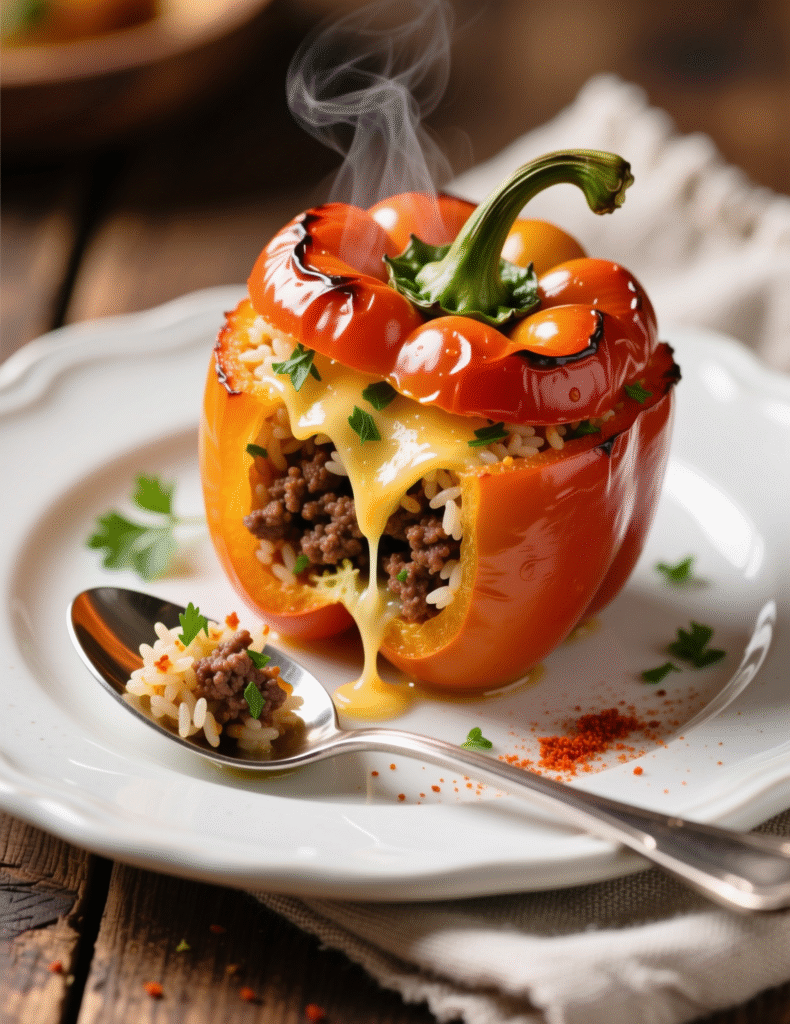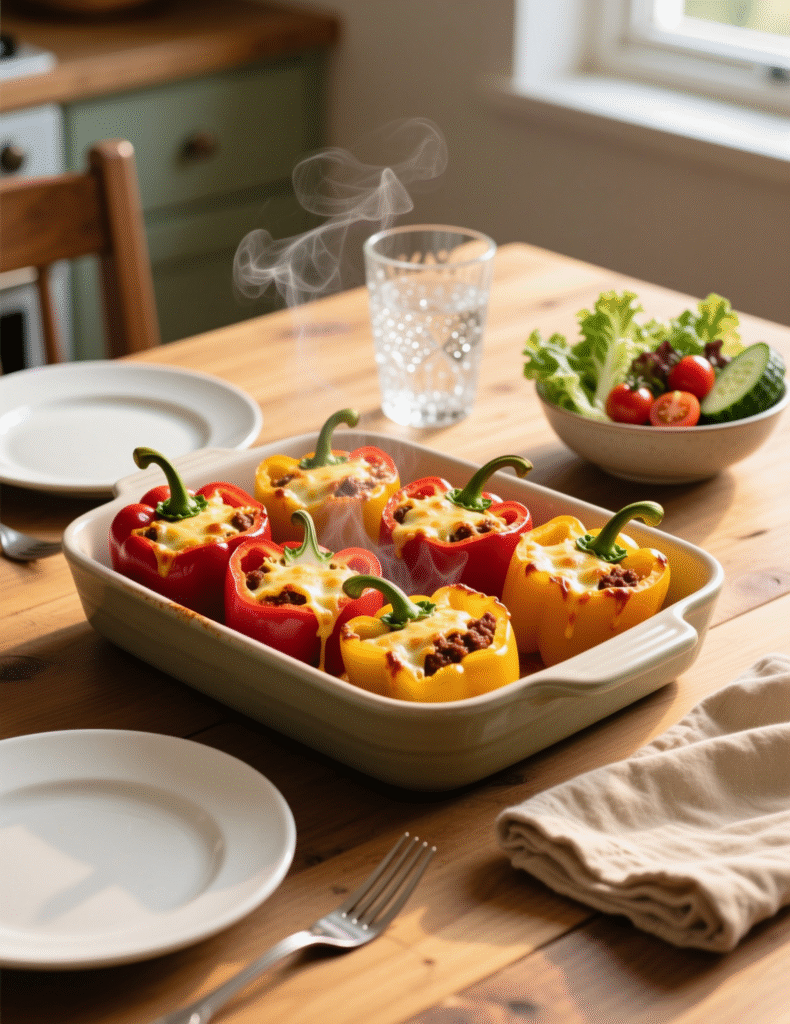Stuffed bell peppers sound like a humble dish, but they’ve got history, depth, and technique tucked right inside them. They’re a staple in kitchens that care about flavor meeting structure. And yet, so many versions are rushed, under-seasoned, or simply don’t do justice to the pepper itself. My purpose here isn’t just to hand you another recipe. It’s to show you how professional chefs think about stuffed peppers, how to cook them for six servings, and how to push this dish from “nice dinner” into something memorable.
Why Stuffed Peppers Work So Well
The bell pepper is basically nature’s edible ramekin. It holds shape, even after roasting, if you treat it right. The sweetness deepens as it cooks, and the cavity begs to be filled with grains, proteins, vegetables, and sauces. For centuries, cultures have leaned on this idea. From Turkish biber dolması to Mexican chiles rellenos, the stuffed pepper concept isn’t new.
When you cook for six people, as in this recipe, precision matters. You’re not just filling a single pepper—you’re balancing ratios across a small group, making sure every bite feels intentional. Overstuff a pepper, and the filling leaks. Under-season it, and the pepper itself dominates.
Ingredients Matter More Than the Method
Here’s the baseline recipe I recommend for six servings:
- 6 large bell peppers (red, yellow, or green, firm, uniform size)
- 1 lb ground beef (or lamb, if you want depth)
- 1 cup cooked rice (long-grain works best, cooled, never sticky)
- 1 medium onion, finely chopped
- 2 cloves garlic, minced
- 1 cup diced tomatoes (canned San Marzano is fine, fresh if peak season)
- 1 cup shredded cheese (mozzarella or a sharper cheddar)
- 2 tbsp tomato paste
- 2 tbsp olive oil
- 1 tsp smoked paprika
- ½ tsp ground cumin
- Salt and black pepper to taste
- Fresh parsley or basil, chopped for garnish
Notice something here. I don’t overload the list. Many home recipes throw in corn, beans, carrots, or three different cheeses. That’s clutter. When cooking at professional level, restraint is more valuable than addition.

Prepping the Peppers
The peppers need a hot water bath before filling. A lot of cooks skip this step, but it’s crucial. Blanch them in salted boiling water for about 3 minutes, then shock in ice water. This locks the color, softens them just enough, and prevents that raw crunch after baking.
I’ve seen restaurants try to roast peppers first, thinking it adds flavor. The problem is, roasted peppers collapse when you stuff them. They look sad on the plate. Blanching is the balance between structure and tenderness.
Building the Filling
Start with the aromatics. Onion and garlic go into a pan with olive oil. Don’t rush. Let them sweat gently, about 8 minutes, until translucent. Then, add your ground beef. Break it apart with a wooden spoon, seasoning immediately with salt, paprika, and cumin. Meat seizes up if left unseasoned too long.
Next, fold in tomato paste. Cook it for 2 minutes until it darkens. This unlocks its sweetness and cuts the raw acidity. Then add diced tomatoes and let the mixture simmer until thickened. Stir in rice last—always cooled rice, never straight from the pot. Hot rice keeps releasing steam and messes with texture inside the pepper.
This filling isn’t flashy, but it’s balanced. You’ve got sweetness, acidity, richness, and body.
Assembling the Dish
Slice the tops off the peppers and remove seeds. Don’t carve too deep—you want a sturdy shell. Spoon filling in, gently pressing down so there aren’t gaps, but don’t overpack. Leave a bit of space at the top, about ½ inch.
Top each pepper with shredded cheese. Not too much—just enough to melt into a crust. Place them upright in a baking dish. If you struggle keeping them upright, wedge foil balls between them or slice a tiny bit off the base of the pepper to create balance.
Pour about ½ cup water or broth into the dish. This creates steam, helping peppers cook evenly. Cover with foil and bake at 375°F (190°C) for 30 minutes. Remove foil, bake another 10 minutes until cheese browns.
Flavor Adjustments for Professionals
A professional kitchen rarely stops at the basic recipe. Here’s where chefs get creative without going overboard:
- Cheese swaps: Manchego, fontina, or even feta for a sharper edge.
- Protein shifts: Ground lamb gives a Mediterranean lean; turkey lightens it.
- Grain alternatives: Quinoa for nuttiness, bulgur for chew.
- Heat factor: A minced chili or Aleppo pepper folded in.
I’ve even done a version with farro, roasted eggplant, and goat cheese for a fine-dining menu. It worked because it leaned on texture contrast, not just flavor.
Nutritional Balance
One stuffed pepper (with beef and rice) lands around 350–400 calories. It carries about 20 grams of protein, 30 grams of carbs, and 15 grams of fat. That balance makes it an excellent one-dish meal.
For diet-specific guests, swap beef for lentils or black beans. You’ll still hit protein goals, and you maintain structure. Stuffed peppers are one of those rare dishes that adapt easily across diets—vegan, keto, gluten-free, whatever your table needs.
Common Mistakes and How to Avoid Them
Too many people serve peppers with filling that’s dry. This happens because they forget moisture control. Always add tomato paste and diced tomato. Without that, rice and meat just sit there like sawdust.
Another error? Undercooked peppers. Blanching fixes this, but so does enough steam in the baking dish. If you’ve ever cut into a pepper that’s still crisp, it means you rushed or skipped the liquid.
Finally, don’t forget seasoning. Salt every step. Peppers themselves are sweet and mild, so the filling has to carry backbone.

The Professional Presentation
When plating for six, resist the temptation to line peppers in a row like soldiers. That’s banquet food, not a professional dish. Instead, serve on warm shallow bowls, drizzle a little reduced tomato sauce around the base, and scatter chopped herbs loosely.
If you want fine-dining level, add a quick balsamic glaze drizzle, or even a dollop of herbed crème fraîche on the side. It breaks the richness.
Emerging Trends: Stuffed Peppers Reinvented
Restaurants now experiment with fusion fillings. Korean-inspired versions use bulgogi beef and kimchi rice. Mediterranean chefs fill peppers with couscous, olives, and preserved lemon. Even plant-forward kitchens stuff them with mushrooms, cashews, and tahini.
What’s interesting is that this humble dish scales well for catering and restaurants. It reheats beautifully, holds structure, and can be batch-prepped without losing integrity. In a food-service study, stuffed peppers ranked as one of the top 20 “reliably plated” entrées in casual dining settings. That’s gold for professionals who need consistency.
Case Study: Efficiency in Prep
In one hotel kitchen I worked in, we prepped stuffed peppers for 80 guests. The trick was par-cooking filling ahead of time, refrigerating it, and filling peppers right before service. Peppers were blanched earlier in the day and held in cold water.
During service, peppers were stuffed, topped with cheese, and baked in batches. That efficiency saved 40% prep time compared to trying to do it à la minute. For anyone cooking for six at home, it’s the same principle. Make filling the night before, and the next day, assembly takes 15 minutes tops.
Professional Tricks You Won’t Find in Home Recipes
- Add a little cinnamon or nutmeg to beef—it deepens flavor subtly.
- Brush inside of peppers with olive oil before stuffing, prevents drying.
- Use two cheeses: one melty (mozzarella) and one sharp (Parmesan) for complexity.
- If plating for guests, slice one pepper in half to showcase the filling cross-section.
These small touches elevate the dish from home comfort to restaurant-worthy.
Conclusion: Why This Dish Still Matters
Stuffed bell peppers aren’t flashy. They’re not the kind of dish you’ll find on a Michelin-star tasting menu. But they embody balance—protein, grain, vegetable, fat, and acid all in one package.
For six servings, they make a dinner party manageable, nourishing, and presentable without requiring endless side dishes. They also adapt, reinvent, and survive across cuisines. That longevity tells you something: they’re worth mastering.
If you treat each step with care—blanching peppers, seasoning in layers, balancing moisture—you’ll end up with a dish that doesn’t just feed people but satisfies them deeply. And that’s the quiet power of stuffed bell peppers done right.
FAQs
What is the best type of bell pepper for stuffing?
Firm, large peppers with flat bottoms work best since they hold shape during baking.
Do I need to blanch bell peppers before stuffing?
Yes, blanching softens peppers slightly and keeps their color vibrant.
Can I make stuffed peppers vegetarian?
Absolutely, use lentils, quinoa, or black beans instead of meat.
How do I stop stuffed peppers from drying out?
Add tomato paste and diced tomatoes to the filling, plus steam in the baking dish.
What cheese works best for topping stuffed peppers?
A mix of melty cheese like mozzarella with sharp Parmesan or cheddar adds depth.
Can I prep stuffed peppers ahead of time?
Yes, prep the filling a day before and assemble just before baking.
How many calories are in one stuffed pepper?
On average, about 350–400 calories per serving with beef and rice.
Why does my filling taste bland?
Most likely under-seasoned—make sure to salt each step as you cook.
Can I freeze stuffed peppers?
Yes, freeze after baking, then reheat in the oven until warmed through.
What side dishes go well with stuffed peppers?
Simple green salads, crusty bread, or roasted vegetables pair perfectly.

Marie Smith is a passionate recipe blogger, sharing easy, delicious, and creative culinary ideas that inspire home cooks to elevate everyday meals with flavor and simplicity.
